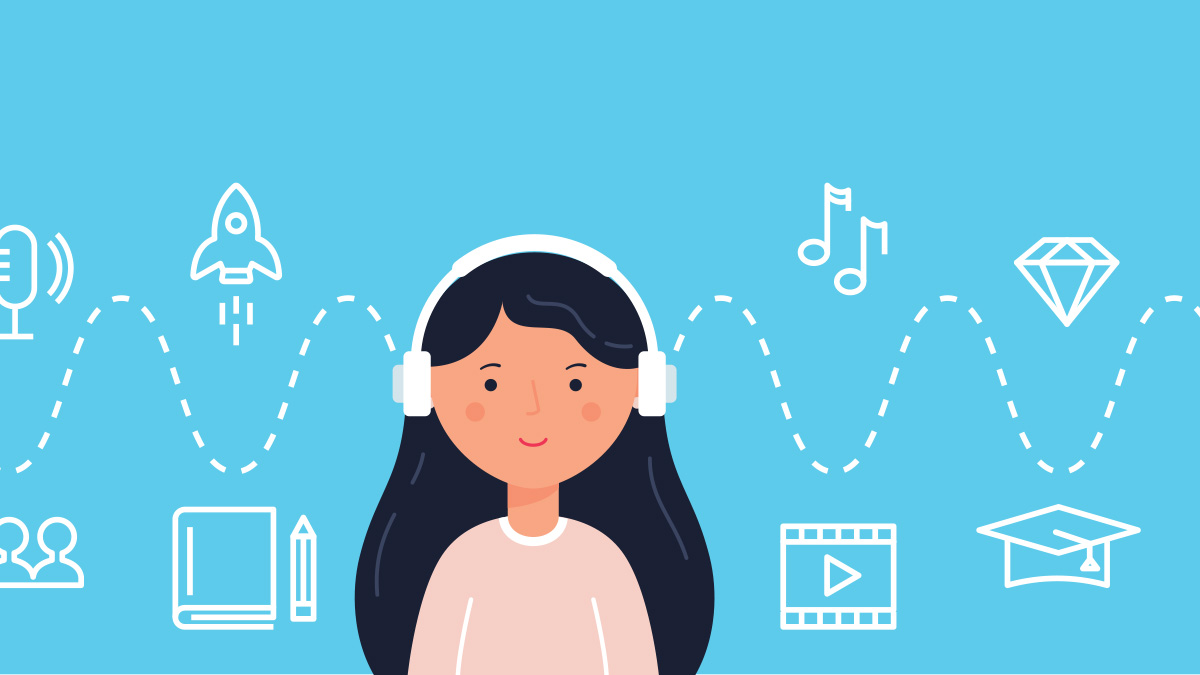
Podcasts Give Students Purpose
The medium enhances communications skills and encourages deep dives into learning.
Topics: Student Engagement
In the bustling main hallway corridor of The Nokesville School, students pause in awe as they transition between periods. Their attention is captivated by their peers in the school’s podcast studio, visible through a full-wall window. It’s not just the cool logo that catches their eye; it’s their friends wearing headphones and speaking passionately into microphones.
Podcasting has taken hold at the school, and we were surprised by the level of engagement and enthusiasm our students exhibited. “My voice sounds weird,” they said. “This is so fun!” “Can I do that again?!”
What is podcasting? Podcasting is a digital media format that enables individuals to create audio content and share it publicly. With more than 2 million podcasts available on everything from general news updates to personal interviews, fictional stories, and thought leadership, the digital age has expanded the realm of education beyond the confines of the traditional classroom. Podcasting has emerged as a popular medium, and schools are embracing it to help students share their passions.
Our First Podcasts
The Nokesville School launched its first foray into podcasting with the goal of highlighting special moments from students and staff, fostering authentic communication, and ultimately, empowering students to have a greater voice in the stories they tell the world. Inspired by the notion of “If you build it, they will come” from Field of Dreams, we set up a studio adjacent to the main hallway.
It took some time to get the technology right, but creating an appealing environment with state-of-the-art equipment proved effective in capturing the curiosity of teenagers. Our studio boasts blacked-out walls, a “Tiger Talk” logo, microphones on swivel arms for easy maneuverability, and headphones to enable students to hear themselves as they speak.
Our first project involved an open-ended fiction assignment in Taylor Crowell’s seventh-grade creative writing class. Crowell provided guidelines, specifying that the genre would be crime stories, but the style and storyline were up to the students. They could work individually or with a partner, with the caveat to keep the content appropriate for a PG rating.
Each story was expected to have a duration of four to five minutes, and students used Microsoft’s “Show Time to Read” function to check the timing. Once their writing was reviewed and approved by Crowell, students were allowed to schedule a recording session.
The students immersed themselves in the process, incorporating fake sponsors, introductions, sound effects, and music. They demonstrated an impressive command of podcasting lingo, concluding their episodes with catchy phrases like, “Make sure to tune in for next week’s story.” Amy Qualls, our instructional technology coach, established a schedule throughout the day for students to visit the podcasting room. Each student group received a brief tutorial from Qualls on reading and recording techniques to ensure optimal sound quality.
In most cases, students completed their readings in one take, but some pieces needed to be edited due to length. Students discovered that reading with inflection results in longer recordings than predicted by the computer tool, accounting for pauses, sound effects, and expressive delivery. While students listened to their recordings, we couldn’t publish all of them online.
Good for Everyone
Engaging in podcasting presented unforeseen challenges that turned out to be valuable learning experiences. Students had to learn to slow down, speak directly into the microphone even when reading from a script, and persevere through mistakes—challenges that made podcasting a truly meaningful learning experience.
Podcasting offers numerous benefits regardless of age. It enhances communication skills by teaching individuals how to articulate ideas, create coherent narratives, and deliver engaging content. It allows for deep dives into nonfiction topics such as gravity in space and storytelling in various genres, from mysteries to historical fiction.
To create an excellent podcast episode, students should follow a system: Clear guidelines, time limits, and modeling are crucial. They should plan the topic, outline the content, and write a script for stories or prepare questions for interviews. A quiet recording room and basic equipment are necessary; even a smartphone can be a powerful recording tool in today’s technological landscape. Free or low-cost editing tools and podcasting platforms are widely available.
Starting out slowly and feeling a bit nervous is fine. The more episodes students record and publish, the better their skills become. Most importantly, they should have fun and find ways to integrate podcast episodes into the existing curriculum and programs. Students will undoubtedly surprise educators with the skills they possess, and joining them in the learning process is an enriching experience.
When Crowell asked her students at the end of the year which lessons she should continue next year, they overwhelmingly said podcasting. It’s an incredible tool that demonstrates our willingness to take risks and step into students’ worlds. It’s not about the devices or the recordings; it’s reimagining education through the eyes of students and their interests. Embrace the opportunity and let podcasting become a catalyst for innovation in your school.
Andy Jacks is principal of The Nokesville School in Nokesville, Virginia.
Amy Qualls is an instructional technology coach at The Nokesville School.
Taylor Crowell is an eighth-grade language arts teacher at The Nokesville School.

